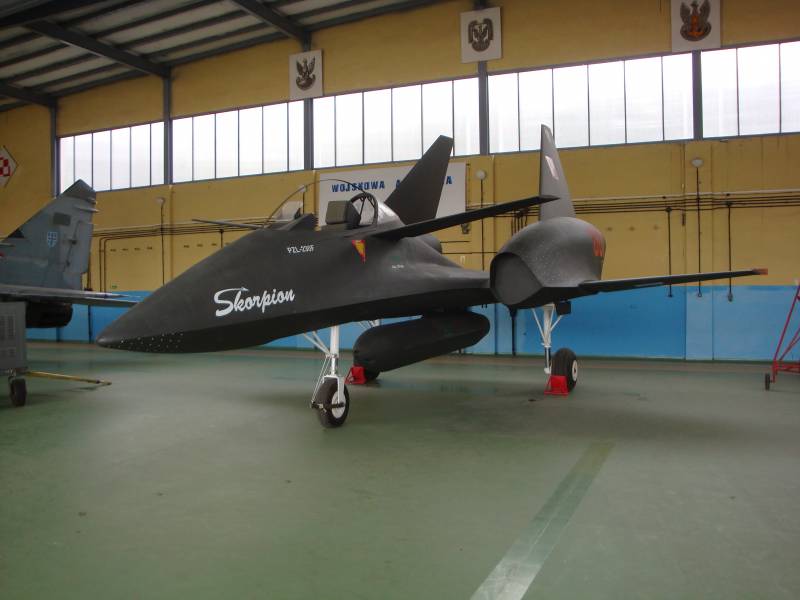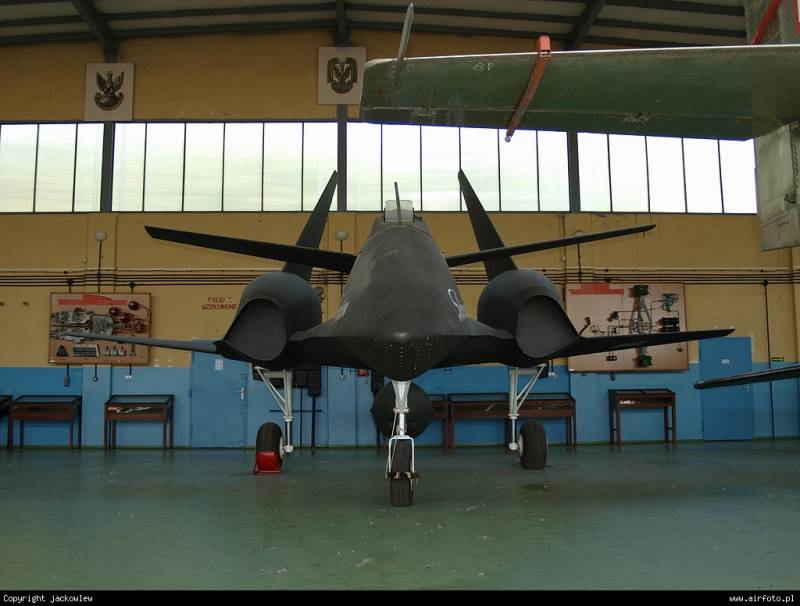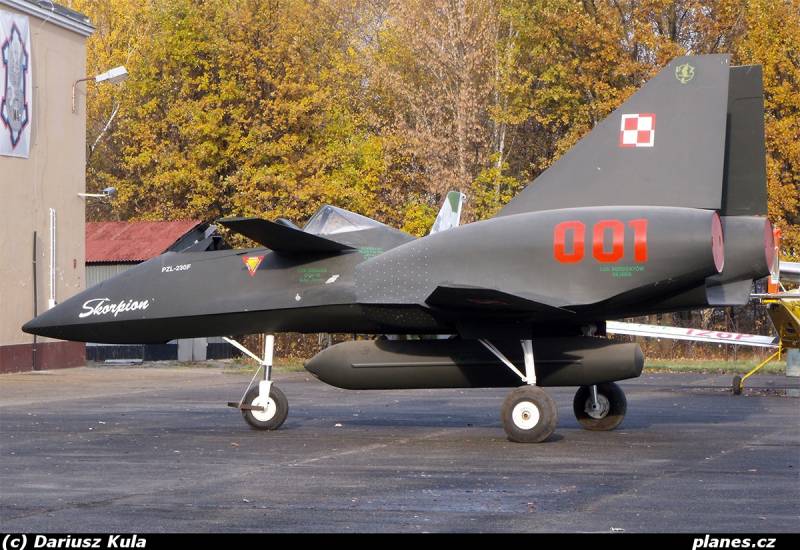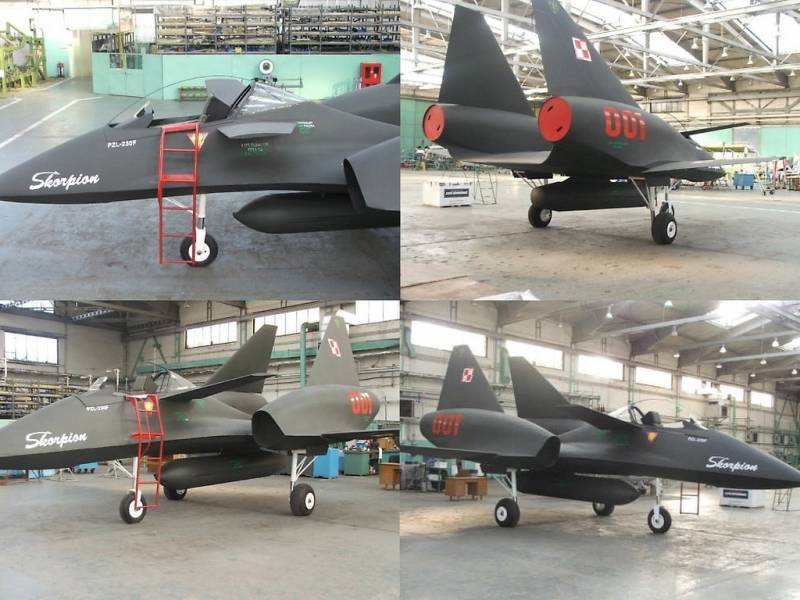Project of the Polish attack aircraft PZL-230 Skorpion
The changing foreign policy situation of the end of 1980-s forced the Polish military to turn to their own aircraft designers. There was a demand for the creation of the Polish combat aircraft. In particular, the Polish military expected to receive an aircraft direct fire support troops on the battlefield. New twin-engine jet attack aircraft received the designation PZL-230 Skorpion. During the project, a full-size mock-up of the future attack aircraft was created, but in 1994, the project was closed due to budget cuts for defense. The economy of the country, which carried out the transition from the communist model to the capitalist one, could not afford further work to create its own combat aircraft. The development priorities of the country at that time did not suggest the existence of serious military spending.
At the end of the 1980s, the PZL plant (the Polish Państwowe Zakłady Lotnicze - State Aviation Plant) took over the development of a new strike aircraft for the Polish Air Force. This is the main and largest aviation enterprise in Poland. It was PZL that was the largest manufacturer of aviation technology in the period between the two world wars, while Polish-made aircraft were in service not only with the Polish Air Force, but were also exported to other European countries. The plant located in Warsaw operated from 1928 of the year to 1939 of the year. Later, starting from the 1950-s, this abbreviation was already used as part of the name of a number of Polish state-owned aircraft factories that were part of the Zjednoczenie Przemysłu Lotniczego i Silnikowego PZL - Association of Aviation and Motor Industries. After 1989, these plants became independent enterprises, which at the same time continued to use the well-known PZL brand.
An attempt to re-develop its own combat aircraft was undertaken at the end of 1980-s by the specialists of the PZL Okęcie plant. Giving the task to designers, representatives of the Polish Air Force wanted to get a new universal combat aircraft designed to directly support the troops on the battlefield, as well as to fight the enemy’s attack aircraft and attack helicopters and UAVs (similar to the concept of a SABA combat aircraft in the UK, which was worked on in 1980- x years).
When creating a new aircraft, its developers took into account the experience of modern war. In particular, the Polish designers studied the experience of the wars in Vietnam and Afghanistan, the practical use of attack aircraft in these armed conflicts. The experience gained in the design and production of the training aircraft PZL-130 Orlik has been of great help to the developers. It was an initial training aircraft, which was developed in Poland in the fall of 1983. The PZL-130 was an all-metal nizkoplan with retractable landing gear with nose support and a hp 750 turboprop engine. The aircraft was designed to train both military and civilian pilots, including aerobatics, striking ground targets, conducting air combat, reconnaissance. The aircraft was produced in Poland in series, on the 2010 year as part of the Air Force had 38 aircraft of this type. The training aircraft could carry various types of weapons placed on 6 suspension units, the combat load was 800 kg.
The first prototype of the new Polish light strike aircraft was ready in the 1990 year. The car received the designation PZL 230 Skorpion. When designing the aircraft and the necessary calculations, computer equipment was actively used. After analyzing a large amount of technical information and accumulated knowledge in the aircraft industry, as well as the experience of actual use of attack aircraft in modern conflicts, the following requirements were formed for the Skorpion aircraft:
- high maneuverability, which was supposed to ensure the survival of the aircraft over the battlefield;
- strong weapons, including modern guidance systems;
- ensuring short take-off and landing, the so-called STOL (Short Take-Off and Landing), the ability to use the aircraft from the front-line airfields, including those with unpaved surfaces;
- compact placement of critical elements in the reserved space, as well as the use of solutions that reduce the susceptibility of the aircraft to the effects of shelling from the ground;
- simple design solutions designed to reduce the cost of attack aircraft;
- the modularity of the design, which was supposed to simplify the conduct of all types of repair work, including in field conditions.
Initially, the new strike aircraft was planned to be equipped with two PT6А-67А turboprop engines (TVD) with pushing propellers. The plane had to accelerate to 640 km / h, the mass of the combat load would be 2000 kg. In this case, together with the aircraft could be used as NATO ammunition, and ammunition of the Warsaw Pact countries. The designers also planned to achieve the possibility of a shortened take-off and landing using runways of the entire length of 250 meters. The first aircraft designs were presented to the military in 1991.
Pretty soon, however, the concept of the strike aircraft was revised. The military asked to increase the flight speed to 1000 km / h, and bring the mass of the combat load to 4 000 kg. To do this, instead of a theater on a plane, it was decided to install two turbojet engines with a high degree of bypass ratio (TRD). At the same time, the length of the runway required for take-off grew; it increased to 400 meters. It was planned that the new attack aircraft can make a controlled flight at angles of attack up to 50 degrees. The plane should have performed a turn of 180 degrees in just 5 seconds.
A full-size model of the new PZL 230 Skorpion attack aircraft was built in the second half of the 1992. Even then, the appearance of the new plane riveted the views of others. The aircraft was made according to the aerodynamic "duck" scheme, in which the pitch longitudinal controls (horizontal tail) are located ahead of the center of gravity of the aircraft (wing). The use of this scheme allows for pitch control without loss of lift to balancing. Airplanes built according to this scheme have the best characteristics of loading capacity per unit area of the wing and maneuverability in pitch. This aerodynamic configuration provides higher load-bearing properties and higher aerodynamic characteristics of the aircraft.
The PZL 230 Skorpion was distinguished by a smooth pairing of the wing and fuselage. The vertical tail of the aircraft was V-shaped. Jet engines were located in separate gondolas on pylons in the tail section of the aircraft. In the construction of the airframe attack aircraft used mainly composite materials. Polish designers also took care of the implementation of individual elements of the Stealth technology. The aircraft body was made flatter compared to the original sketches; there were practically no projections and side planes on it, which could be natural reflectors of electromagnetic waves. The cockpit Martin-Baker MK.10L was installed in the cockpit, installed with a slope of 34 degrees. In this chair, the pilot could withstand overloads up to 9g. The cockpit was armored, she was supposed to protect him from bullets of caliber reaching 12,7 mm.
The possibility of installing three different engines on an aircraft was considered: the Pratt-Whitney Canada TRDD PW305 (2х2380 kgf), Textron Lycoming LF505 (2х2840 kgf) or Garrett ATF3 (2х2480 kgf). Avionics and a set of electronic equipment, both Polish and Western production. The cockpit should have an indicator on the windshield (HUD), multifunctional cabin indicators on color cathode ray tubes, and an inertial navigation system (INS). The presence of an electrically controlled control system (EDS) was also planned.
The main armament of the attack aircraft was the 4-squadron 25-mm GAU-12 / U aircraft gun manufactured by General Electric (300 rounds of ammunition). Also, an 7-30-mm GAU-8 aircraft gun of the same company, designed specifically for the American A-10 attack aircraft, could be suspended under the fuselage of the aircraft. The aircraft could use various bombs, including the KAB, NAR and air-to-air and air-to-surface guided missiles, which were located on the 13 external suspension units.
Flight technical characteristics of the PZL-230D "Skorpion":
Overall dimensions: length - 10 m, height - 4,2 m, wing span - 12,1 m, wing area - 25,4 m2.
Take-off weight - 11 000 kg.
The maximum flight speed is 1000 km / h.
Combat radius of action - 300 km.
Practical ceiling - 12 000 m.
Rate of climb - 90 m / s.
Combat load - up to 4 000 kg on 13 external suspension units: bombs (including CAB), NAR, SD air-to-air and air-to-surface.
Armament - four-barreled 25-mm gun GAU-12 / U (300 shells).
Crew - 1 man.
Information sources:
http://www.dogswar.ru/oryjeinaia-ekzotika/aviaciia/570-proekt-shtyrmovika-p.html
http://alternathistory.com/proekt-shturmovika-pzl-230f-skorpion-polsha
http://www.strategie.com.pl/dzial/zbrojownia/artykul/296
Open source materials




Information